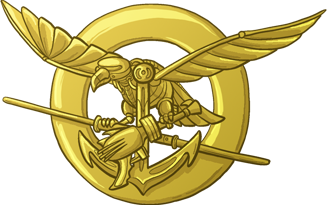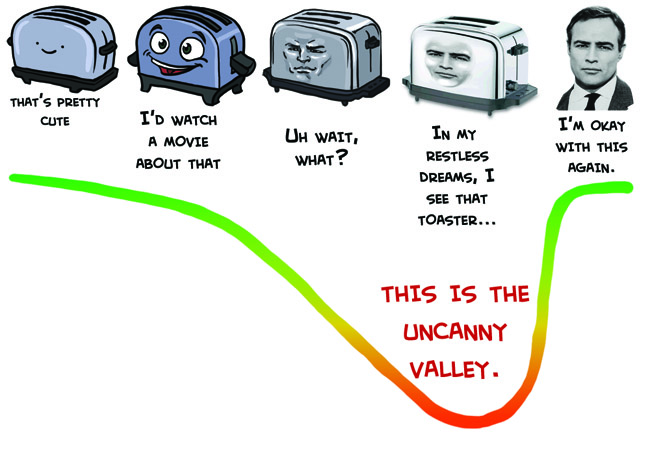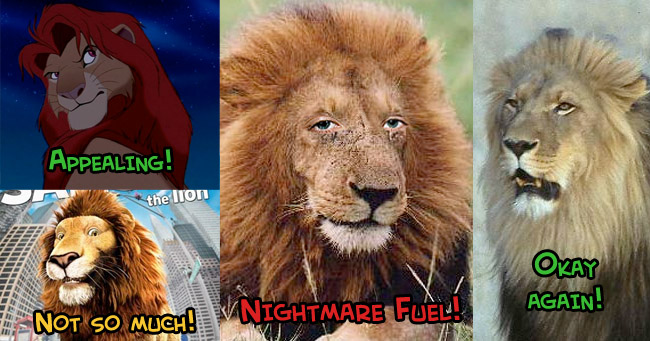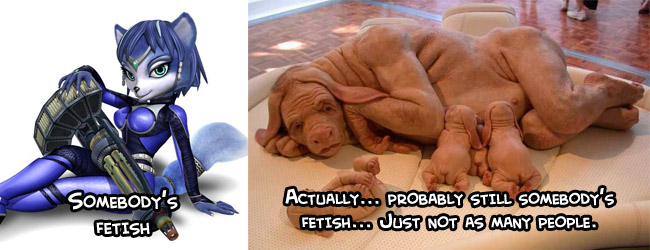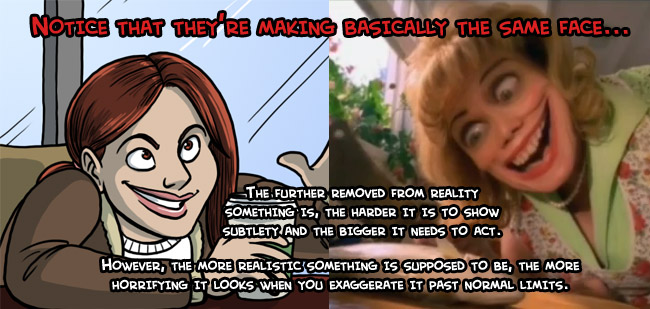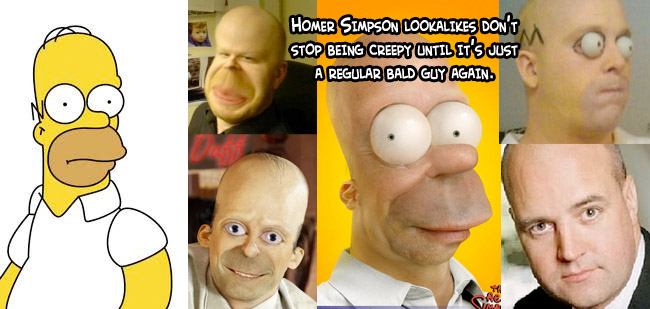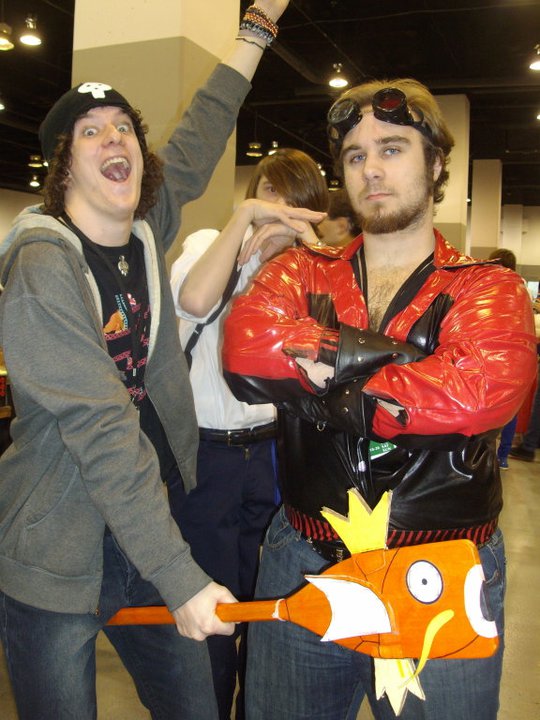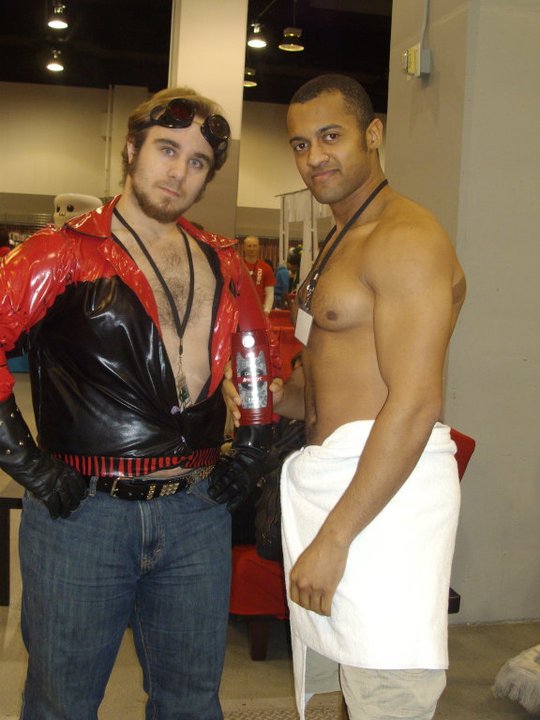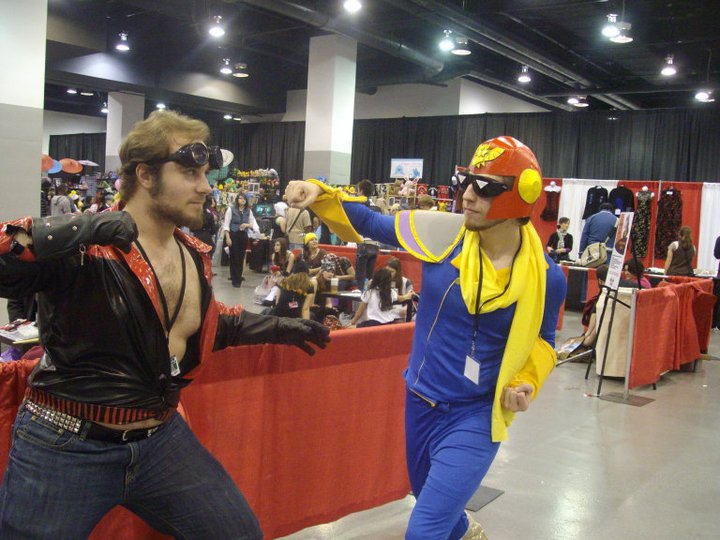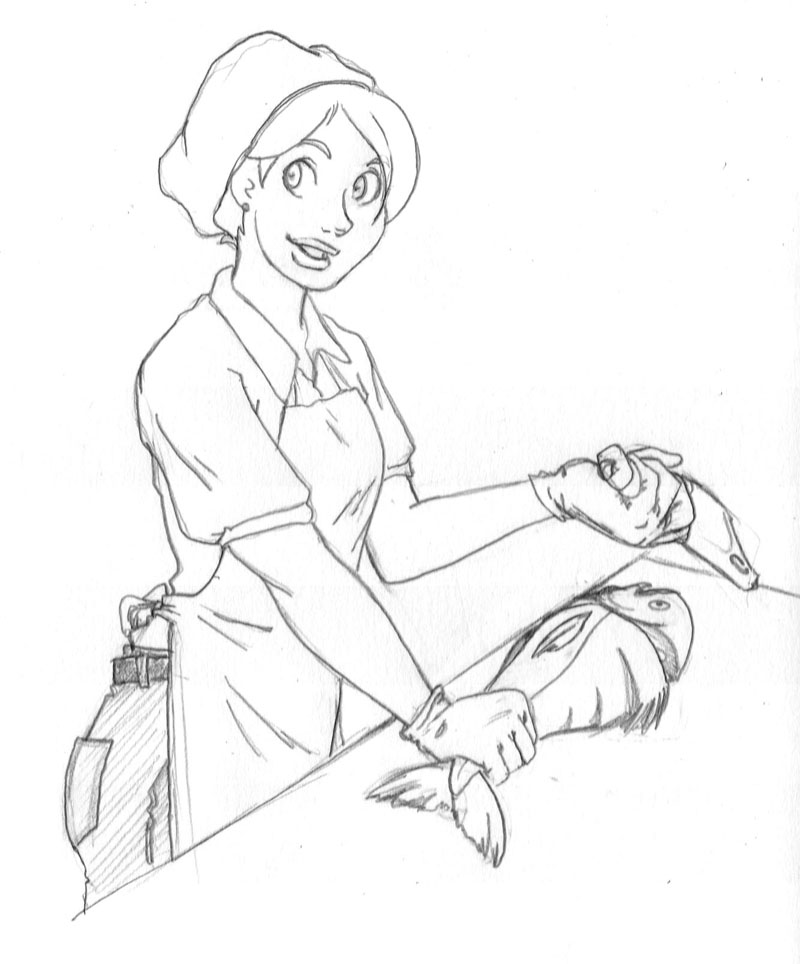Anyone who has any aptitude at drawing will be asked at some point “how do I learn how to do that?”, and it seems to me that when people care to go into a more elaborate response than “Practice all the time” they are usually advising people to read up on a lot of Hogarth and Loomis, and learn all of the fundamentals before they start trying to get creative. I think one of the best pieces of drawing advice for beginners I ever saw was once upon a time on DeviantArt when Modus Operandi’s artist Tish Doolin told someone that if you were just picking up a pencil and trying this drawing thing out for the first time, it’s going to benefit you more to draw things that you have fun with than struggling with dry fundamentals right out of the gate.
Learning to draw is a little like learning to speak a language, the younger you get into it, the easier a time you’ll have with it and the less you’ll remember the uphill struggle it took to get where you are. It seems that if you ask the majority of talented artists when they started to draw, they’ll answer “as soon as I could hold a crayon”. Bearing in mind that most toddlers and grade school children do not have the patience to pore over Bridgeman’s anatomy guides, it’s safe to say that many very talented individuals out there did not get the “proper” start that they recommend to others. It is true that getting the basics down will save you years of mediocrity, but frankly, learning to draw is hard. If it feels like a chore and if you aren’t getting any kind of instant gratification out of it, you’ll probably give up before you get anywhere. Like language, you don’t jump right int the thick of it off the get go. Start simple, imitate, immerse yourself, and keep at it to grow. If drawing sonic fanart is what it takes to get you going, by all means, draw some hedgehogs and work on leveling up to the point where you’re motivated to really get your elbows in.
THAT SAID, it is wholly possible to draw for a long time and not go anywhere. Unfortunately, it’s not just a “do it a lot and you’ll get good” situation, your advancement completely depends on how willing you are to expand your horizons. Without trying to insult anyone or beat a dead horse, take the comic Dominic Deegan, for example
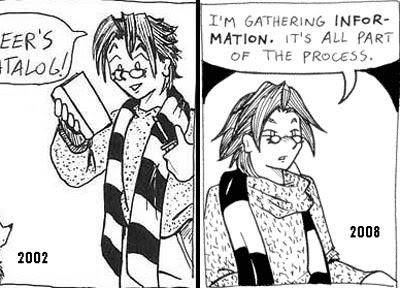
These two panels are drawn six years and something like 1500 strips apart. I am not going to say that the art has not improved, because there is definitely a difference in his balance and structure between the first comic and the last, but it has not made the improvement that you would expect to see if practice alone was enough to make leaps and bounds. This is not meant to be an attack against the artist or fans of the comic at all, just an observation that doing a ton of drawing isn’t guaranteed to alter your approach to the craft (Maybe his personal non-comic related work has changed more? I’d like to give him the benefit of the doubt, I looked for some but I didn’t find any). If you want me to put my own head on the chopping block, this is what Six years of making a conscious effort to improve did for me. Still a long way to go, but you don’t have to look too hard to figure out which one came later. If you never try to figure out what you could be doing better and expand your repertoire, you will continue to make the same mistakes for as long as you draw.
Anyway, here are some bits of advice I have. Things I learned the long way that might help others hobble down that road to improvement. Obviously this is pretty biased towards cartoony stuff, cartoons take up something like 20 hours of any given day in my life so… well… write what you know, huh? I apologize for how long winded it is, If anyone knows how to do something similar to LJ cuts with wordpress, I’d be all ears.
Draw From Life
This is the cornerstone to improving, there is no way around it. Draw everything, this doesn’t just mean nude life drawing, draw people walking around at parks, draw people in mall food courts, draw people on the subway, draw animals at the zoo, draw restaurants and bars while you’re waiting for your food to come, draw your living room, draw your pets, draw everything you see whenever your hands are idle. I have piles of tiny pocket-sized sketchbooks that I keep on me just for doodling whenever the opportunity arises. Moleskine sells them in packs of three for ten bucks, dollar stores sometimes have little hardcover ones for a buck or two. I’ve gone so far as to rifle pocket-size watchtower bibles out of recycling bins and rebind them with scrap paper from discarded folders and legal envelopes. There is no reason to not have a sketchbook and a ballpoint pen on hand at any given time.
Nude and costumed life drawing is something I really have to recommend as well. I have seen people claim that life drawing is unnecessary if you can just use photo reference instead, but I would have to argue that this is not the case if you’re using the opportunity to it’s fullest advantage. Real bodies show you how anatomy works in a way photos never can. Imagine you’re looking at a picture of an engine, chances are you just see a daunting piece of machinery. But if you see an engine in real life, have the opportunity to turn it around and see what it looks like when it runs you’ll start to understand what’s pushing and pulling at what and have a little more understanding of what parts are most important and why. It’s just as important to pay attention to the model easing in and out of their poses and how the muscles and fat deposits bunch and fold and squish and change shape through the poses as it is to study the individual poses themselves. Personally I don’t have much patience for poses outside the 30 second to five minute range, that’s plenty of time to get down the information that you’re going to benefit the most from.
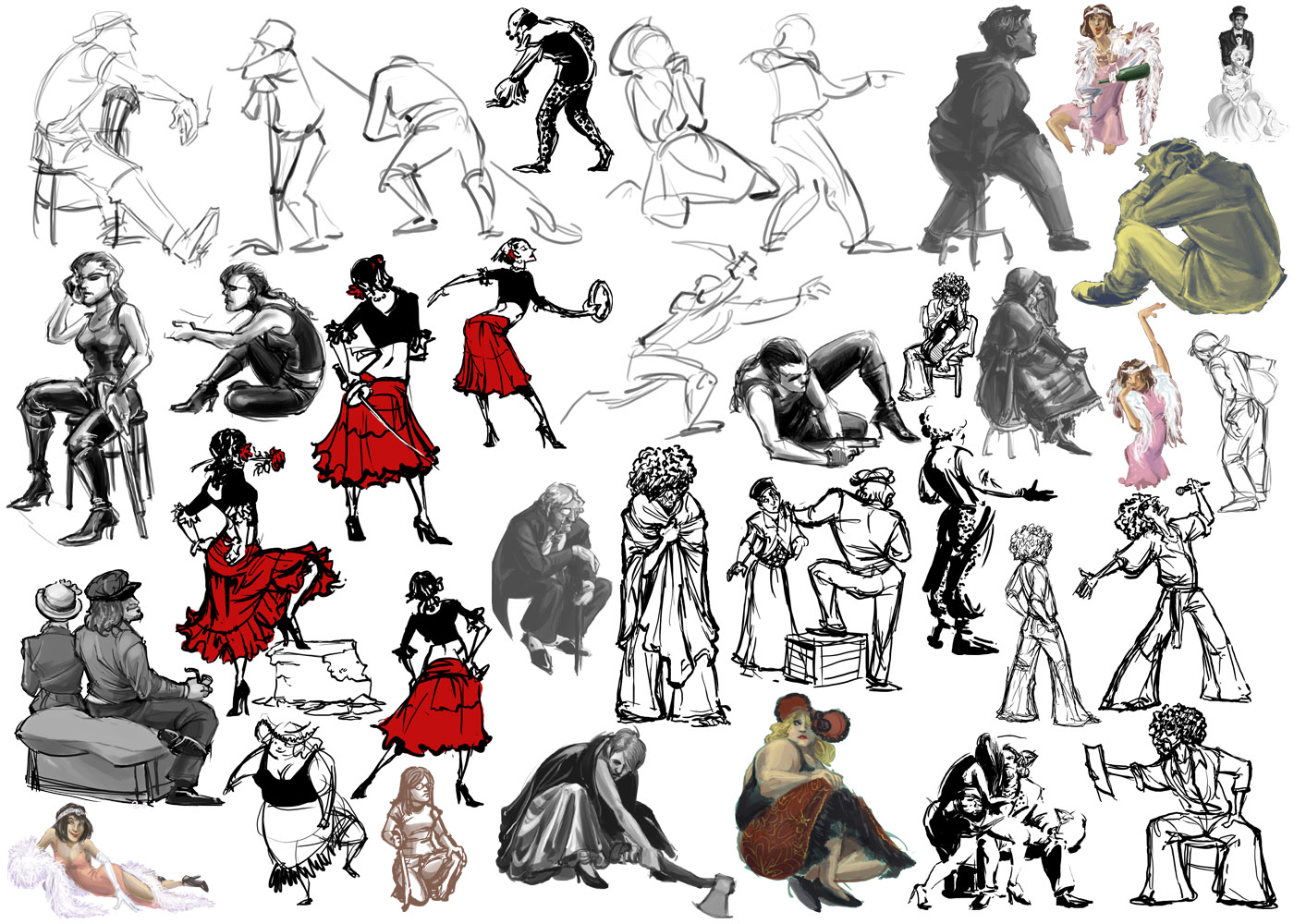
If you just dive into it and start drawing without any kind of research or instruction, you’re probably going to have a frustrating time. You want to know that idealized figures are eight heads high, the pubic symphysis is the halfway point of the body, elbows come to the bottom of the ribs, wrists come to the crotch, the forearm is approximately the same length as the foot, all that sort of business before you even put pencil to paper. A friend of mine gave me a very useful piece of advice when I was starting out at Sheridan, it really helps you understand what you’re looking at and speed up your progress if you research specific muscle groups and then go into a lifedrawing session paying attention to those parts of the body. Remember, the point of lifedrawing isn’t to make pretty pictures you can hang on your wall, it’s to improve your understanding of how the body fits together and operates. If drawing nothing but armpits and kneecaps for an hour is what you think you need to do to move to the next level, break out the newsprint and have at it.
I know Loomis is a favourite recommendation for artists starting out, but I feel like choosing him as your go-to guy is going to leave your art a little stiff in the end. If I had to pick my cream-of-the-crop anatomy books that helped me out the most personally I’d have to put Human Anatomy for Artists: the Elements of Form at number one with Bridgman’s Complete Guide to Drawing from Life and Hogarth’s Dynamic Figure Drawing as runner ups. Jack Hamm did a book on animal anatomy I’m quite fond of as well.
Structure is Key
I am of the opinion that structure will ALWAYS matter more than proportions. It doesn’t matter if you have you have the formula for drawing perfectly proportioned limbs tattooed on the back of your hand, if you draw joints and muscle groups with a clear lack of understanding regarding how things fit together and what attaches where, your characters will never look right. Conversely, as long as you know how things fit together you can stretch and squash the actual proportions as much as you want and still have an appealing character that shows you know what you’re doing.
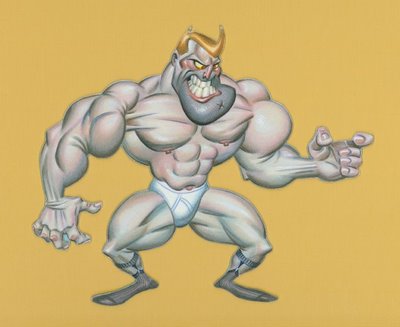
Proportionately, this is completely unlike any human you’ll ever see. But it’s structurally sound so you aren’t left feeling like “wah-hey, I don’t think this guy knows his chops…” This applies to just about anything human or human-like from talking animals to sponges, as long as the connectivity and overlap operates in a way that makes sense and reminds the viewer of something real they’ve seen moving around, you’re gold. A short PDF I see bob up every now and then on Disney Story sketching (I’m not going to track down the download and pass on a link for fear of rousing the ire of the House of Mouse, but it’s out there) identifies to this sort of exaggeration as “scale” and cites Composing Pictures by Donald W. Graham as a further reference on the matter. The idea is that you are de-emphasizing unimportant areas and exaggerating the features that you want the viewer to pay attention to. This is really the heart of caricature.
Figure things out for yourself
Tish did a pretty amazing write-up on this over on her DeviantArt Gallery that’s really worth checking out for more of an in-depth exploration of the subject. The short of it is, things will ALWAYS look wrong if you learn to draw them from copying the way other artists have chosen to stylize them rather than understanding how they work for yourself. This really seems to be a hangup that kids who learn to draw exclusively from copying anime or comic books have to get over. You need to think of a character as a three dimensional object sitting in space and figure out how to best represent that, don’t treat them like a composite of two dimensional symbols. People who base their entire artistic repertoire on what they have seen someone else draw will never really understand why they’re making those choices, so everything they make is going to seem slightly off-kilter. This doesn’t just apply to cartoonists, I have heard professional portraiture artists complain that their students just learn the formula to drawing a face, place those features on the head, and end up with something incredibly flat and uncanny valley.
Figuring out how to draw by studying “this is how artist-I-like draws a nose” or “this is how artist-I-Like draws eyes” is a little like playing telephone. The artist has created something one generation removed from the original image they were trying to capture. You drawing what they drew is another generation removed from that. Things can become lost in translation and if you don’t understand why an artist chose to represent something a certain way you won’t be able to move the character properly, apply those conventions to other situations, or alter the idea to suit the requirements of a different setup. THAT SAID;
Reference other Artists
It actually seems a pretty common occurrence that people who want to draw cartoons then focus on nothing but realism have a really hard time with their cartoons when the time comes. There’s some myth out there that stylized drawings are “easy”, so once you learn to make “real art” you can just backtrack and do anything. This is not the case, drawing cartoons, figuring out the right amount of exaggeration and making an obviously abstract 2D representation of something real look like it has life and mass is a whole art form unto itself.
Referencing is not the same as copying as I just finished defining it a couple paragraphs back. Referencing is just studying how an artist handles a situation so that you can decide a way that you might want to approach a similar situation in the future. Referencing is figuring out the hows and why of style conventions, copying is just accepting that they do work and taking them for yourself. Referencing is a tool that helps you make decisions for yourself and grow as an artist, while people who flatly copy their idols at their absolute peak will only ever be just as good as an imitation of someone else. If you spend your life following someone, you will always be behind them.
We are all the sum of our parts, every one of us is influenced by everything we ever see, hear, say, or do. What we bring to the table is our interpretation of all of those happenings, which we try to present in the most appealing or interesting way possible to the best of our abilities. Studying the ground other artists have already broken is nothing but a tool to help us figure out how to look at something from a new perspective, and there’s no reason to shy away from it.
All Art is Self Taught
When I was a kid I learned how to draw through my own trial and error and the occasional piece of friendly advice. Then I graduated and went to an art school and realized that… well… art school is just a venue that saturates you in trial and error and friendly advice. Art is not like math or physics where anyone paying attention to a lesson on how to apply an equation will learn how to properly execute it. Learning to draw or paint is similar to learning a martial art, someone can explain the mechanics of it to you but you won’t be able to properly execute it without the practice and dedication it takes to train your hands to sync up with what your brain wants them to do. A school cannot force you to learn or succeed, you can only ever go as far as your own motivation will take you. Chances are if you learned to draw well enough to get into an art school, you’ve already been working on that self-motivation.
People will debate ad nauseum over whether or not going to university to learn how to draw prettier pictures is a worthwhile endavour. TRUTH! Everything you learn in an art school you could probably find in a book somewhere. TRUTH! Your grades aren’t going to get you a job, your portfolio is what matters! Does art school really make a difference? WELL THAT DEPENDS. Basically what you’re paying for when you go to a school for art are deadlines and connections. You decide how important that is to you. Are you a highly motivated individual who treats learning like a job, lives in an area with a flourishing artistic community, makes sure to be a prominent figure in the local art scene hitting up all of the appropriate conventions, community projects and mixers to aggressively make your name known, and apply for as many jobs as you can find? Yes? Then no! You probably don’t need art school!
My story, I was born and raised in one of the most sparsely populated corners of the world, just far enough south of the arctic circle that we had trees. There is no “art scene” there. Aside from the high school art teacher, I was the “art person” in town. I moved to Southern Ontario to go to Sheridan for animation when I was 17, had my first paying network television job the summer before I turned 21, got hired to work on a prime-time Comedy Central series around the time I turned 22, and had a job lined up working on an MTV cartoon in Hollywood by my 23rd birthday. If I had stayed in Northern Canada trying to teach myself everything and find jobs without the help of any of the friends I made at school, I’d probably still be in Northern Canada trying to teach myself everything. School gives you a clear deadline for when they’re going to kick you out of the nest, so you have a very firm date that you need to make yourself come off as a presentable professional by.
Constantly Challenge Yourself
Around the time I was 15 or so, I saw someone on an internet forum complaining about artists who fill their galleries with nothing but drawings of the same character standing in the same pose over and over again. And it’s true, I’ve seen many an artist in my travels who draws a STELLAR Disney-style animal character standing in a 3/4 pose and smiling. And nothing else. Around that time I made it my goal to quit cold turkey and never draw another character just standing there and not doing anything. It’s easy to become comfortable drawing one thing and put all of your effort into polishing that off, while neglecting everything else, it’s why you see so many people who draw competent 3/4 views of characters fall flat on their faces as soon as they need to draw a profile or back of someone’s head. If you don’t try to draw something, you’ll never learn how to draw it.
Drawing a lot of talking heads and people standing in flat 3/4 views not doing anything isn’t doing anyone any favours. It’s boring to look at, it’s boring to draw, and no one learns anything. It’s not hard to add some visual interest to a character’s pose and it’s a quick way to wordlessly flesh out their lives. Remember this strip from back in November? Okay, now imagine it looked like this;
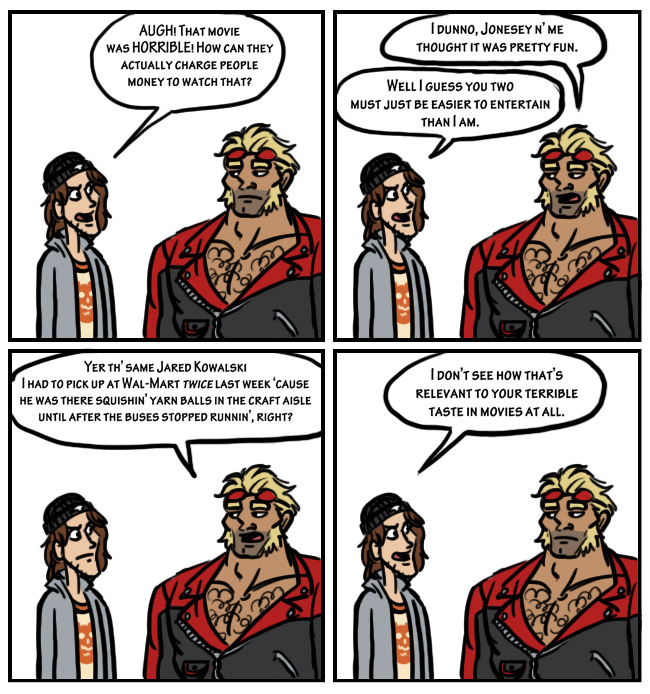
WOW. THAT’S HORRIBLE. I wouldn’t want to read that comic, I can tell you that. The characters are uninteresting, the body language and reactions make the joke flat and irritating. It was easy to draw, though. If the strip looked like this I could update every day! I don’t know who would read it but boy howdy there would be a lot of it.
It’s really painless to add some personality and make a drawing more entertaining to look at than “person standing in 3/4 runway pose”. These are some sketches I did for people on DeviantArt one month in a stretch of unemployment after I graduated and the economy had just bottomed out where I was doing five dollar internet commissions to pay my rent. Just giving them a prop to interact with or reading a brief description of their personality can be enough to tell a whole story with a quick doodle.
Don’t Hate on Successful People
How many times have you heard someone ranting about how much they hate another person’s art because the artist in question is more popular than they believe is deserved? Because it seems to come up a lot. There are so many variables that factor into a person’s popularity that aren’t “how good they draw” or “how good they write” it’s a complete waste of time to try to cut them down. It’s that whole “Oh well I could do that” “Yeah but you didn’t” situation that comes up whenever people discuss art. From my experience, artists who have great networking skills, meet their deadlines, and are pleasant to work with are the artists who continue to find work. It doesn’t matter how talented you are, if no one knows your name, you’re unreliable, or you always leave a trail of drama in your wake you aren’t going to have an easy time finding work.
As far as story writing goes, really, the simpler a story is the more people it has the potential to appeal to. You have to choose your audience because as soon as you start introducing concepts that make people think, you’re going to start alienating readers. You could craft your deep and moving magnum opus that makes people laugh and cry and feel for everything the characters go through, and it probably won’t get as many hits as the popular gag-a-day du jour. But really, is that the audience you were expecting your story to attract? The people who like to laugh at countdowns on The Oatmeal aren’t necessarily the same people who are going to appreciate the mounting political unrest in The Meek. Simple strips are like potato chip art, anyone can just chew through a stack of them without thinking about it. Big projects are the New York steak dinner of the webcomic world, ultimately higher quality and more satisfying but something you really need the time to savour.
Don’t Hate on Newbies
Everyone has to start somewhere. If you’re out tearing down people just starting out, you’re just being an ass. If you have any measure of artistic talent yourself, you went through those sloppy days too. This is what ten years of drawing did to one of the lead characters in a different comic story I tinker with on and off;
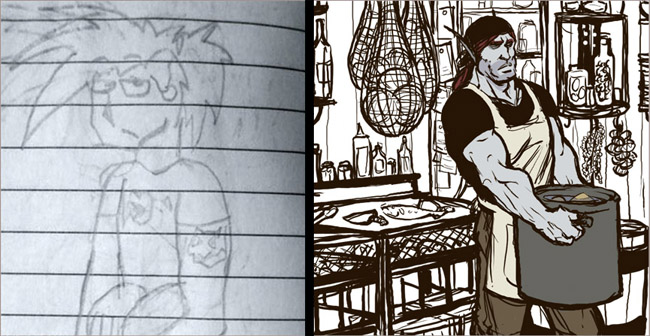
Few and far between are the fledgling artists who can’t improve without some practice and constructive criticism. You don’t have to sugar coat your suggestions and handle them with the kiddie gloves, but telling someone they suck and they should stop drawing is just being a dick.
Don’t Hate On Yourself
Everyone who’s guilty of getting into self-pitying sadness wank-offs, just stop it. Right now. There is nothing more annoying to listen to than an artist waxing on about how much they suck and how they’ll never get anywhere. I think Natalie Dee put it best in one strip where she points out that “all you’re born knowing how to do is eat and complain” or something to that extent. Yeah, I get it, all artists are invariably disappointed in themselves. Everyone sees nothing but the mistakes when they look at their own art, everyone is always measuring themselves up against other people and thinking they come up short and wishing they had done better. The only artists I know who don’t go through that are massively self-important ego maniacs. But honestly, if most people spent a fraction of the time identifying their specific issues and working on them that they do crying on the internet about how bad they are at their hobby, wow, they’d be published professionals by now.
And frankly, if someone compliments something you’ve done and you brush it off by saying you suck, you’re insulting their taste for liking what you made. And if you force them into a situation where they have to wax poetic and fluff up your ego to convince you to accept a compliment, you don’t deserve the compliment anyway. If you feel self conscious accepting a lot of kind words about something you made, don’t just brush it off with “bleh, I suck”, say something like “Thanks! I really wish I had spent a little more time on *insert problem area here*, though”. That way you show them that you appreciated the compliment, you identified your specific issue with the drawing that you can work to improve next time, and you didn’t turn the situation into a self-pity circle jerk.
I think the single most important thing they taught me at Sheridan was not to belittle myself. Sheridan is very much a school made to prepare people to get out into the industry and did numerous lectures on conducting job interviews and building portfolios. Basically, they told us that if you go into a situation saying you suck and apologizing for your work, any stranger without a reason to try to make you feel better is just going to accept that you suck and your work needs to be apologized for.
Bear in mind that being confident does not mean you need to lack humility. Honestly, I am well aware that I have a long way to go. I don’t have the skills of an artist to rattle off the same professional polish on a weekly basis that Boxer Hockey does, I can’t pull off the tangible atmosphere of Lackadaisy or the solid animated flow of the Meek. I don’t render like Modus Operandi or make clever witticisms like Nedroid and Hark a Vagrant. But I know that doesn’t mean I suck, it just means that I’m aware of what I need to work on.
Art is dynamic, it’s exciting because there is always new ground to break. There is no ultimate conclusion, It’s like evolution. There is always the opportunity for your abilities to grow and change.



